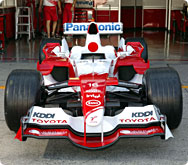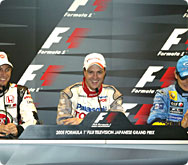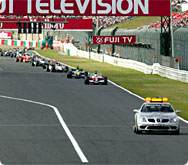| Hello, everyone. Thank you so much for your support over the weekend. Takahashi here with a report from the Japanese Grand Prix.
Both Jarno and Ralf will be driving the long-awaited TF105B at the Japanese Grand Prix. The primary aim of the TF105B was improved aerodynamics. We gained more effective airflow by changing the layout of the front suspension, and this gives us both better aerodynamic effects and improved mechanical grip at the same time. I think this will lead to improved times on a circuit like Suzuka where the complex corners require a car that has a front end you can keep under control. Both Jarno and Ralf will
also be running fresh engines. Both engines are a new specification providing more power than the prior version. The 2005 season will come to an end with the Suzuka race and next race in China, so this will be our final, most powerful version of the V10 RVX-05 engine.
• Friday: Rain, but a complete program
 |
 |
| The TF105B entered into the Japanese GP features major changes in suspension layout and shape. |
|
Our team weather report called for rain to fall around 2:30 p.m. during the afternoon free practice, so we adjusted our program with the weather in mind. The track surface had yet to build up during the morning session, we couldn’t complete our comparison of the two types of tires we brought with us. We only figured on 30 minutes of effective time for the afternoon session, so we made car setup our main focus of the morning, leaving 30 minutes for tire comparisons in the afternoon.
Rain fell just as predicted, so we actually had only one-and-one-half hours of effective session time, but we were still able to collect all the data we needed for tire selections. Ricardo’s car stopped dead on the track with electrical system problems about 10 minutes before the end of the morning practice session. Ricardo originally thought that he had a broken gearbox, since the clutch wouldn’t open and engage, but once we looked into the problem back in the pits, we found out the
problem was electrical. We changed out the problem area, and the car was ready to run without any trouble for the afternoon.
Our impression was that Ralf had no problems at all with the new TF105B during the morning, so we worked on correcting some fine details to complete his setup. With all of the work we put into the car to that point, there really wasn’t much else to do to improve it. On the other hand, Jarno hadn’t seemed to develop a feel for the car yet, so we didn’t complete his setup during the day. We had a large volume of data from earlier testing sessions, so we believed we could move things
in the right direction without undue difficulty.
With Ricardo’s car, we were able to confirm a definite increase in engine output. For Saturday, we planned to have our regular drivers run their engines at the same level of RPMs as they would during the race. The weather report calls for wet weather on Saturday, with cloudy but dry conditions on Sunday. Our biggest challenge is putting together a compromise setup that will work well under both conditions.
• Saturday: Capturing our second pole position on the greatest stage possible
 |
 |
| |
Ralf wins his first pole position since joining Panasonic Toyota Racing. This makes the sixth pole of his career. |
Even though we received some help from the weather, nothing can diminish our pride at capturing our second pole of the year, and Ralf’s first pole with Panasonic Toyota Racing. This was the best stage to win a pole that we could have dreamed of, and our entire team is extremely happy.
I’ll recap from the morning. As we forecast, it rained the entire morning, so we broke in the intermediate tires and the heavy wet tires during Practice Session 3. We assumed that qualifying would be wet as well, so we took the last 15 minutes of Practice Session 4 to run a qualifying simulation with a different setup that took the Sunday race into consideration.
Jarno was scheduled to take his qualifying lap as the 8th driver, and there was still quite a bit of water standing on the track surface. All in all, I think Jarno attacked right to the edge of what he could do with the car. We could have slowed his pace down to protect his qualifying position, but in our point of view, we would rather have him push the car, even at the risk of spinning out, which is what ended up happening. Jarno spun out, but I don’t think that could have been helped given
the track conditions at the time.
On the other hand, Ralf made his attack at the perfect time. Ralf made the most of the conditions, and also brought out the best in the TF105B spec engine. It was a truly wonderful, mistake-free performance.
Since we expected dry conditions for the race tomorrow, our car setups had to balance the wet qualifying conditions as well as the dry conditions expected for Sunday. Our race strategy balanced these factors as well. Since the rain will continue to wash away the rubber from the track, the key to the race will be how effectively we will be able to use our tires throughout the race. We’re starting on the pole, and we fully intend to use our tires to best effect, landing squarely in the center
spot of the podium.
• Sunday: The unexpected appearance of the safety car ruins our strategy
 |
 |
| As the safety car stayed out, the team saw their carefully crafted strategy fading away. |
|
We did everything we could to capture the pole and finish at the top in the race, but we feel terribly that we couldn’t meet our fans’ expectations. We had put together an aggressive race strategy for Ralf, incorporating three pit stops. Ralf had a strong start, and built a growing gap between himself and Fisichella (running second) over laps one and two. Unfortunately, that was the time that the safety car came out.
Normally, the safety car will be off the track after one or two laps, but for some reason, the car stayed out for five entire laps, which basically destroyed the benefits of our three-stop strategy.
Our strategy called for Ralf, whose machine was light on fuel, to pull away from the trailing cars after the start, and to have built up a 10-second lead by the time he was ready to take his first pit on lap 11. This would allow him to pit out in a strong position. Unfortunately, our strategy was completely thrown off as the safety car remained out on the track, keeping Ralf from establishing a sufficient lead before his first pit stop.
Although we considered switching to a two-stop strategy during the race, we had gone with low-temperature option tires, and the longer the car was out on the track, the worse the drop-off would be in the rear tires. The fact of the matter was that if we wanted to save our tires, a two-stop strategy would have been risky.
With Jarno, we mapped out a strategy that would let us have two or three pit stops. Since he spun out during qualifying, we decided to go with a two-stop race. We hoped that both cars would be able to finish the race to provide us a complete set of data for the TF105B, but sometimes things don’t always work out as hoped.
In any event, it’s obvious that we still aren’t as competitive as we need to be. The power and speed of the McLaren is so impressive. We will have to conquer the McLaren next year, and then are still many things we have to accomplish between now and then. Although Jarno had to retire from the race, we still did get some valuable data for the 105B. We will use this data to help us at the Chinese Grand Prix to compete against the monster McLaren machine.
There’s one race to go in the 2005 season. You can be sure we will be bringing all of our efforts to bear on this final race, and I hope we’ll be able to report great things back to our fans. Thank you again for visiting the official Panasonic Toyota Racing website. I will be back with the final race report of the season from the Chinese Grand Prix. Until then…
|